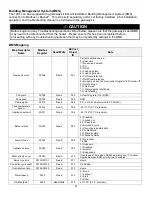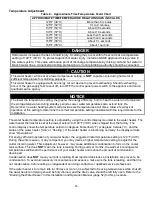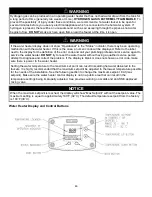
54
Temperature and Pressure Relief Valve
At least twice a year, the temperature and pressure relief valve should be checked to ensure that it is in
operating condition. To check the relief valve, lift the lever at the end of the valve several times. The valve
should seat properly and operate freely.
If water does not flow, remove and inspect for obstructions or corrosion. Replace with a new valve of the
recommended size as necessary. A thorough inspection of the valve should be performed at least every three
years by removing the temperature and relief valve from the tank. Do
NOT
attempt to repair the valve, as this
could result in improper operation and a tank explosion. In areas with poor water conditions, it may be
necessary to inspect the T&P valve more often than the recommended maintenance schedule.
CAUTION
Before manually operating the valve, make sure that a drain line has been attached to the valve to direct
the discharge to an open drain. Failure to take this precaution could mean contact with extremely hot water
passing out the valve during this checking operation.
If the temperature and pressure relief valve on the water heater discharges periodically or continuously, it may
be due to thermal expansion of water in a closed water supply system, or it may be due to a faulty relief valve.
Thermal expansion is the normal response of water when it is heated. In a closed system, thermal expansion
will cause the system pressure to build until the relief valve actuation pressure is equaled. Then, the relief
valve will open, allowing some water to escape, slightly lowering the pressure. Contact your water supplier or
local plumbing inspector on how to control this situation.
WARNING
DO NOT
plug the temperature and pressure relief valve. This is
NOT
a solution and can create a
hazardous situation.
Vent and Air Intake System
Examine the vent and air intake system every 3 months. Points of inspection are as follows:
1. Check for obstructions and/or deterioration of vent piping and vent terminal. Replace immediately where
needed.
2. Vent pipe and vent terminal screen should be cleaned of any foreign material. The screen is located
inside the vent terminal outlet and is accessible from the outside of the vent terminal elbow.
Do
NOT
reach inside the vent terminal when the water heater is in operation.
3. Check all venting system connections for leakage and reseal as required.
Combustion System Inspection
Inspect the operation of the combustion system monthly. Use the following procedure to inspect the
combustion system.
1. Adjust the thermostat to the minimum setting.
2. Turn OFF the main power switch of the water heater.
3. Remove the surround by unlatching it then lift it up and forward to remove.
4. Turn ON the main power switch.
5. Adjust thermostat to the maximum setting.
6. Watch the front display as the controller goes through the sequence of operations as previously
described.
7. Upon ignition, observe the main burner flame.
8. Readjust thermostat to previous setting.
9. Replace surround on top and latch it securely in place.
Summary of Contents for LUHE120T
Page 42: ...42 BMS Wiring Diagram...
Page 44: ...44 Lighting and Shutdown Instructions Figure 31 Lighting Instruction Label...
Page 62: ......
Page 63: ......











































